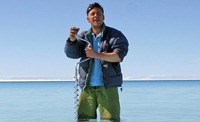Understanding the processes that lead to ice mass acceleration

Dr Alun Hubbard drilling into the ice below a lake in Greenland
14 January 2014
The Greenland Ice Sheet is losing ice mass at an increasing pace which at present is around 200 cubic km per year, enough to raise global sea levels by 0.6 mm per year and according to the latest International Panel on Climate Change (IPCC) report, most likely to render sea levels higher by 50cm within our century.
This is a worrying prospect given the recent flood and storm damage in the UK.
Research shows that in some places, the world's glaciers are melting up to 100 times faster than any time during the last 350 years, which will have significant implications for the future.
Academics at Aberystwyth University have been awarded £340,000 to research into the processes that drive the fast flow of these glaciers because a growing body of evidence points to a strong response to both oceanographic and atmospheric forcing.
Brothers Bryn and Alun Hubbard from the Geography and Earth Sciences Department will carry out surveys and drill boreholes up to 1,000m deep through an outlet glacier of the Greenland Ice Sheet to make detailed experiments and observations of how such glaciers move over their bedrock and sediment base.
Professor Bryn Hubbard explains, “The rationale of this project is to investigate mechanical and hydrological conditions at the bed of Store Glacier, a large marine-terminating glacier, in Greenland in order to understand what mechanisms are responsible for the sensitive response of these glaciers to changes in climate and surrounding ocean.
“Our first challenge will be to drill - using hot, pressurised water pumped down a long hose-pipe - a series of boreholes of up to 1 km length to gain access to, and install instruments at the interface at which the ice sheet rests on its rock and debris base.
“With instruments deployed at the bed, on the glacier’s surface and near its calving front, the project will be able to unravel the controls on ice flow and the glacier’s response to on-going climate change.”
Professor Alun Hubbard says “Calving icebergs and melt-water runoff from the Greenland ice sheet are making the most significant and direct contribution to global sea level rise, which is currently accelerating at an alarming rate. That is a grim prospect indeed for the very densely populated, low-lying, coastal areas of our planet.”
AU414



